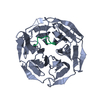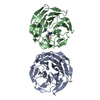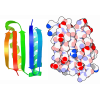[English] 日本語
 Yorodumi
Yorodumi- PDB-8ejs: Kelch domain of human KEAP1 bound to Nrf2 linear peptide, Ac-(BAl... -
+ Open data
Open data
- Basic information
Basic information
| Entry | Database: PDB / ID: 8ejs | ||||||
|---|---|---|---|---|---|---|---|
| Title | Kelch domain of human KEAP1 bound to Nrf2 linear peptide, Ac-(BAla)DPETGE-NH2 | ||||||
 Components Components |
| ||||||
 Keywords Keywords | PROTEIN BINDING / Protein interaction / inhibitor | ||||||
| Function / homology |  Function and homology information Function and homology informationpositive regulation of glutathione biosynthetic process / aflatoxin catabolic process / negative regulation of hematopoietic stem cell differentiation / integrated stress response signaling / Regulation of HMOX1 expression and activity / negative regulation of cellular response to hypoxia / NFE2L2 regulating TCA cycle genes / PERK-mediated unfolded protein response / positive regulation of ERAD pathway / regulation of removal of superoxide radicals ...positive regulation of glutathione biosynthetic process / aflatoxin catabolic process / negative regulation of hematopoietic stem cell differentiation / integrated stress response signaling / Regulation of HMOX1 expression and activity / negative regulation of cellular response to hypoxia / NFE2L2 regulating TCA cycle genes / PERK-mediated unfolded protein response / positive regulation of ERAD pathway / regulation of removal of superoxide radicals / regulation of cellular response to oxidative stress / cellular response to laminar fluid shear stress / regulation of epidermal cell differentiation / NFE2L2 regulating ER-stress associated genes / NFE2L2 regulating inflammation associated genes / mediator complex / cellular response to fluid shear stress / cellular response to methionine / NFE2L2 regulates pentose phosphate pathway genes / NFE2L2 regulating MDR associated enzymes / positive regulation of ubiquitin-dependent protein catabolic process / Nuclear events mediated by NFE2L2 / Regulation of NFE2L2 gene expression / negative regulation of response to oxidative stress / negative regulation of cardiac muscle cell apoptotic process / NFE2L2 regulating tumorigenic genes / NFE2L2 regulating anti-oxidant/detoxification enzymes / negative regulation of ferroptosis / proteasomal ubiquitin-independent protein catabolic process / Cul3-RING ubiquitin ligase complex / regulation of innate immune response / negative regulation of vascular associated smooth muscle cell migration / cellular response to angiotensin / regulation of embryonic development / positive regulation of blood coagulation / positive regulation of blood vessel endothelial cell migration / negative regulation of endothelial cell apoptotic process / ubiquitin-like ligase-substrate adaptor activity / negative regulation of oxidative stress-induced intrinsic apoptotic signaling pathway / endoplasmic reticulum unfolded protein response / transcription regulator inhibitor activity / cellular response to glucose starvation / inclusion body / cellular response to interleukin-4 / reactive oxygen species metabolic process / cell redox homeostasis / cellular response to copper ion / response to ischemia / transcription coregulator binding / positive regulation of D-glucose import / actin filament / Heme signaling / molecular condensate scaffold activity / GSK3B and BTRC:CUL1-mediated-degradation of NFE2L2 / protein-DNA complex / positive regulation of neuron projection development / centriolar satellite / RNA polymerase II transcription regulator complex / cellular response to xenobiotic stimulus / cellular response to hydrogen peroxide / positive regulation of reactive oxygen species metabolic process / positive regulation of angiogenesis / disordered domain specific binding / cellular response to tumor necrosis factor / KEAP1-NFE2L2 pathway / Antigen processing: Ubiquitination & Proteasome degradation / positive regulation of proteasomal ubiquitin-dependent protein catabolic process / Neddylation / cellular response to oxidative stress / response to oxidative stress / DNA-binding transcription activator activity, RNA polymerase II-specific / midbody / ubiquitin-dependent protein catabolic process / cellular response to hypoxia / in utero embryonic development / sequence-specific DNA binding / Potential therapeutics for SARS / proteasome-mediated ubiquitin-dependent protein catabolic process / RNA polymerase II-specific DNA-binding transcription factor binding / DNA-binding transcription factor activity, RNA polymerase II-specific / transcription cis-regulatory region binding / Ub-specific processing proteases / regulation of autophagy / protein ubiquitination / ciliary basal body / RNA polymerase II cis-regulatory region sequence-specific DNA binding / inflammatory response / DNA-binding transcription factor activity / protein domain specific binding / ubiquitin protein ligase binding / centrosome / positive regulation of gene expression / regulation of transcription by RNA polymerase II / chromatin / positive regulation of DNA-templated transcription / endoplasmic reticulum / negative regulation of transcription by RNA polymerase II / Golgi apparatus / positive regulation of transcription by RNA polymerase II / DNA binding Similarity search - Function | ||||||
| Biological species |  Homo sapiens (human) Homo sapiens (human) | ||||||
| Method |  X-RAY DIFFRACTION / X-RAY DIFFRACTION /  SYNCHROTRON / SYNCHROTRON /  MOLECULAR REPLACEMENT / Resolution: 2.82 Å MOLECULAR REPLACEMENT / Resolution: 2.82 Å | ||||||
 Authors Authors | Muellers, S.N. / Allen, K.N. | ||||||
| Funding support | 1items
| ||||||
 Citation Citation |  Journal: To Be Published Journal: To Be PublishedTitle: The benefit of cyclization: a comparison of cyclic and linear peptide inhibitors of the KEAP1/Nrf2 protein-protein interaction Authors: Muellers, S.N. / Allen, K.N. / Whitty, A. | ||||||
| History |
|
- Structure visualization
Structure visualization
| Structure viewer | Molecule:  Molmil Molmil Jmol/JSmol Jmol/JSmol |
|---|
- Downloads & links
Downloads & links
- Download
Download
| PDBx/mmCIF format |  8ejs.cif.gz 8ejs.cif.gz | 245.2 KB | Display |  PDBx/mmCIF format PDBx/mmCIF format |
|---|---|---|---|---|
| PDB format |  pdb8ejs.ent.gz pdb8ejs.ent.gz | 187.7 KB | Display |  PDB format PDB format |
| PDBx/mmJSON format |  8ejs.json.gz 8ejs.json.gz | Tree view |  PDBx/mmJSON format PDBx/mmJSON format | |
| Others |  Other downloads Other downloads |
-Validation report
| Summary document |  8ejs_validation.pdf.gz 8ejs_validation.pdf.gz | 450.1 KB | Display |  wwPDB validaton report wwPDB validaton report |
|---|---|---|---|---|
| Full document |  8ejs_full_validation.pdf.gz 8ejs_full_validation.pdf.gz | 460.9 KB | Display | |
| Data in XML |  8ejs_validation.xml.gz 8ejs_validation.xml.gz | 23.9 KB | Display | |
| Data in CIF |  8ejs_validation.cif.gz 8ejs_validation.cif.gz | 33 KB | Display | |
| Arichive directory |  https://data.pdbj.org/pub/pdb/validation_reports/ej/8ejs https://data.pdbj.org/pub/pdb/validation_reports/ej/8ejs ftp://data.pdbj.org/pub/pdb/validation_reports/ej/8ejs ftp://data.pdbj.org/pub/pdb/validation_reports/ej/8ejs | HTTPS FTP |
-Related structure data
| Related structure data |  8ejrC  5wfvS S: Starting model for refinement C: citing same article ( |
|---|---|
| Similar structure data | Similarity search - Function & homology  F&H Search F&H Search |
- Links
Links
- Assembly
Assembly
| Deposited unit | 
| ||||||||||||
|---|---|---|---|---|---|---|---|---|---|---|---|---|---|
| 1 | 
| ||||||||||||
| 2 | 
| ||||||||||||
| Unit cell |
|
- Components
Components
| #1: Protein | Mass: 36899.176 Da / Num. of mol.: 2 / Fragment: UNP residues 320-812 Source method: isolated from a genetically manipulated source Source: (gene. exp.)  Homo sapiens (human) / Gene: KEAP1, INRF2, KIAA0132, KLHL19 / Production host: Homo sapiens (human) / Gene: KEAP1, INRF2, KIAA0132, KLHL19 / Production host:  #2: Protein/peptide | | Mass: 715.687 Da / Num. of mol.: 1 / Source method: obtained synthetically / Source: (synth.)  Homo sapiens (human) / References: UniProt: Q16236 Homo sapiens (human) / References: UniProt: Q16236#3: Water | ChemComp-HOH / | Has ligand of interest | Y | Has protein modification | Y | |
|---|
-Experimental details
-Experiment
| Experiment | Method:  X-RAY DIFFRACTION / Number of used crystals: 1 X-RAY DIFFRACTION / Number of used crystals: 1 |
|---|
- Sample preparation
Sample preparation
| Crystal | Density Matthews: 2.59 Å3/Da / Density % sol: 52.47 % |
|---|---|
| Crystal grow | Temperature: 290 K / Method: vapor diffusion, hanging drop Details: 1.6 M ammonium sulfate, 100 mM Bis-Tris pH 6.5, 0.2-0.8% PEG monomethyl ether (MME) 550 |
-Data collection
| Diffraction | Mean temperature: 100 K / Serial crystal experiment: N |
|---|---|
| Diffraction source | Source:  SYNCHROTRON / Site: SYNCHROTRON / Site:  SSRL SSRL  / Beamline: BL12-2 / Wavelength: 0.987 Å / Beamline: BL12-2 / Wavelength: 0.987 Å |
| Detector | Type: DECTRIS PILATUS 6M / Detector: PIXEL / Date: Jul 1, 2021 |
| Radiation | Protocol: SINGLE WAVELENGTH / Monochromatic (M) / Laue (L): M / Scattering type: x-ray |
| Radiation wavelength | Wavelength: 0.987 Å / Relative weight: 1 |
| Reflection | Resolution: 2.82→39.4 Å / Num. obs: 18329 / % possible obs: 98.46 % / Redundancy: 13.2 % / Biso Wilson estimate: 33.12 Å2 / CC1/2: 0.934 / Rmerge(I) obs: 0.585 / Rpim(I) all: 0.164 / Rrim(I) all: 0.608 / Net I/σ(I): 3.4 |
| Reflection shell | Resolution: 2.82→2.921 Å / Redundancy: 13 % / Rmerge(I) obs: 0.91 / Mean I/σ(I) obs: 1.8 / Num. unique obs: 1838 / CC1/2: 0.747 / Rpim(I) all: 0.26 / Rrim(I) all: 0.947 / % possible all: 98.87 |
- Processing
Processing
| Software |
| |||||||||||||||||||||||||||||||||||||||||||||||||
|---|---|---|---|---|---|---|---|---|---|---|---|---|---|---|---|---|---|---|---|---|---|---|---|---|---|---|---|---|---|---|---|---|---|---|---|---|---|---|---|---|---|---|---|---|---|---|---|---|---|---|
| Refinement | Method to determine structure:  MOLECULAR REPLACEMENT MOLECULAR REPLACEMENTStarting model: 5WFV Resolution: 2.82→39.4 Å / SU ML: 0.302 / Cross valid method: FREE R-VALUE / σ(F): 1.33 / Phase error: 25.1806 Stereochemistry target values: GeoStd + Monomer Library + CDL v1.2
| |||||||||||||||||||||||||||||||||||||||||||||||||
| Solvent computation | Shrinkage radii: 0.9 Å / VDW probe radii: 1.11 Å / Solvent model: FLAT BULK SOLVENT MODEL | |||||||||||||||||||||||||||||||||||||||||||||||||
| Displacement parameters | Biso mean: 49.54 Å2 | |||||||||||||||||||||||||||||||||||||||||||||||||
| Refinement step | Cycle: LAST / Resolution: 2.82→39.4 Å
| |||||||||||||||||||||||||||||||||||||||||||||||||
| Refine LS restraints |
| |||||||||||||||||||||||||||||||||||||||||||||||||
| LS refinement shell |
|
 Movie
Movie Controller
Controller


 PDBj
PDBj






